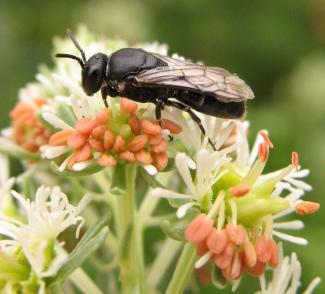
Image Credit: Nigel Jones
Pollen-regurgitating bees (Colletidae: Hylaeus)
These bees are worldwide in distribution, and especially abundant in Australia. There are about 50 species in North America – probably the most distinctive bees our native fauna (but they are tiny!). They are nearly completely bare of hair; are black and shiny, and with very prominent yellow/white markings on their legs, thorax and face. The species are most easily distinguished by their facial patterns (males and females are very different).
They are unique among all bees in that they swallow pollen at the flower and return to the nest to regurgitate it to provision their cells. Whether this behavior was the primitive form of cell provisioning or possibly an advanced adaptation to living in very narrow tubes in the pith of plant stems (and hence having any pollen on their legs or belly scraped off upon entering the nest) is an open question. This behavior is shared, though, with the masarid hornet-bees, a completely independent evolutionary branch of hornets which evolved into functional “bees”. Most Hylaeus bees are generalists, but I have noticed that their diets are seriously restricted by the relative volumes of different types of pollen grains; they seem to be completely excluded from collecting (and regurgitating!!) large pollen types (cacti, evening primroses, blueberries, mallows, etc.), As a result our Northwest species are relegated almost entirely to plants of the carrot and rose families. In fact, we have 2 species (most closely related to Asian fauna) that are specialists on cinquefoil (Potentilla).
Like their close cousins, Colletes, they line their burrows and cells with silk and provision the young with soupy mixes of pollen and nectar. They seem to prefer pre-existing cavities in plant stems or in the ground. I have seen their distinctive tiny silk-lined cells in the abandoned nests of diverse stem- and ground-nesting bees.


Hylaeus are tiny to rather small bees, which resemble small wasps very closely. There is really no way to distinguish them without a microscope. The females don’t help with the identification, since they carry all their pollen to the nest within their bellies. On the right-hand picture, note that the two sexes have strikingly different facial color patterns. The male marks always include the upper lip (“the clypeus”), whereas the clypeus of the females is generally all black.